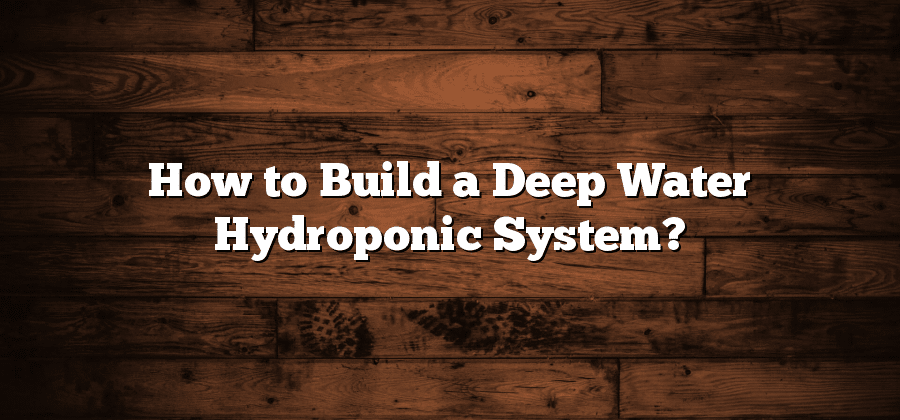Understanding Deep Water Hydroponics
Deep water hydroponics is an advanced gardening technique that allows plants to grow in water instead of soil. With this method, the roots are suspended in a nutrient-rich solution that provides all the essential elements needed for growth. This innovative approach to gardening offers several benefits, including increased plant growth rates, reduced water usage, and the ability to grow a wide variety of plants regardless of soil quality.
One of the key advantages of deep water hydroponics is the enhanced oxygenation of the root system. By ensuring that the roots have a constant supply of oxygen, plants are able to grow at a faster rate and produce healthier, more vibrant foliage. This technique is particularly advantageous for plants that typically struggle in compacted or nutrient-poor soils. In deep water hydroponics, the nutrient solution can be precisely controlled, providing an optimal balance of essential elements that are readily available to the plant roots. This not only promotes healthy growth but also eliminates the need for fertilizers and reduces the risk of nutrient deficiencies.
Selecting the Right Plants for Deep Water Hydroponics
When it comes to selecting the right plants for a deep water hydroponics system, there are a few key factors to consider. First and foremost, you’ll want to choose plants that are well-suited to growing in water. This means selecting plants that have a high tolerance for waterlogged conditions and can thrive without the need for soil.
One popular choice for deep water hydroponics is lettuce. Lettuce varieties such as romaine and butterhead grow particularly well in water-based systems, and their shallow root systems make them a perfect fit for the deep water culture technique. Other leafy greens like spinach and kale can also be successful in deep water hydroponics, as they have similar water requirements and can thrive in nutrient-rich water solutions.
In addition to leafy greens, herbs like basil and cilantro are also great choices for deep water hydroponics. These plants not only add a fresh flavor to meals but also grow exceptionally well in water-based systems. Their compact size and relatively shallow root systems make them easy to manage in a deep water hydroponics setup.
Before selecting plants for your deep water hydroponics system, it’s important to research specific varieties to ensure they are compatible with the growing method and have the necessary water requirements. Additionally, consider factors like yield potential, growth rate, and overall plant health to make the best choices for a successful deep water hydroponics garden.
Choosing the Ideal Location for Your System
Finding the ideal location for your deep water hydroponic system is crucial for its success. When selecting a spot, ensure that it receives ample sunlight throughout the day. Sunlight is essential for photosynthesis, the process through which plants convert light into energy. Without enough sunlight, your plants may struggle to grow and produce a bountiful harvest.
In addition to sunlight, consider the accessibility of the location. You will need to regularly monitor and maintain your hydroponic system, so choose a spot that is easily accessible for watering, nutrient checks, and any necessary adjustments. It is also important to ensure that the location is well-ventilated, as proper air circulation is essential for preventing the growth of mold and other harmful pathogens that can harm your plants. By carefully considering these factors, you can choose an ideal location that will promote the health and productivity of your deep water hydroponic system.
Gathering the Necessary Materials and Equipment
To successfully set up a deep water hydroponic system, it is essential to gather all the necessary materials and equipment before diving into the project. This not only ensures a smooth construction process but also eliminates the hassle of having to make frequent trips to the store. So what exactly do you need? Let’s start with the basics.
First and foremost, you will need a good quality tank or container that can hold water. This will serve as the main reservoir for your hydroponic system, providing the necessary space for the solution and the plants’ root systems. It is important to choose a tank that is durable, leak-proof, and of an appropriate size for the number of plants you plan to grow. Additionally, you will need an air pump and air stones to provide oxygenation to the water, promoting healthy root growth. These can usually be found in hydroponic supply stores or online. Other essential materials include net pots, which will hold the plants in place, and a pH testing kit to monitor and adjust the acidity or alkalinity levels of the nutrient solution.
Constructing the Deep Water Hydroponic System Frame
When it comes to constructing the frame for your deep water hydroponic system, there are a few key steps to keep in mind. First, you’ll need to gather the necessary materials and equipment, such as PVC pipes, connectors, and a drill. Make sure you have all the components before starting the construction process to avoid any unnecessary delays.
Next, you’ll want to carefully plan out the design and layout of your system. This includes deciding on the dimensions of your frame and determining how many plant sites you want to accommodate. It’s important to ensure that the frame is sturdy and can support the weight of the water and plants. Additionally, consider the height of the frame, as this will dictate how deep the water will be and can impact the success of your hydroponic system. Taking the time to carefully construct a strong and well-designed frame will set a solid foundation for your deep water hydroponic system.






